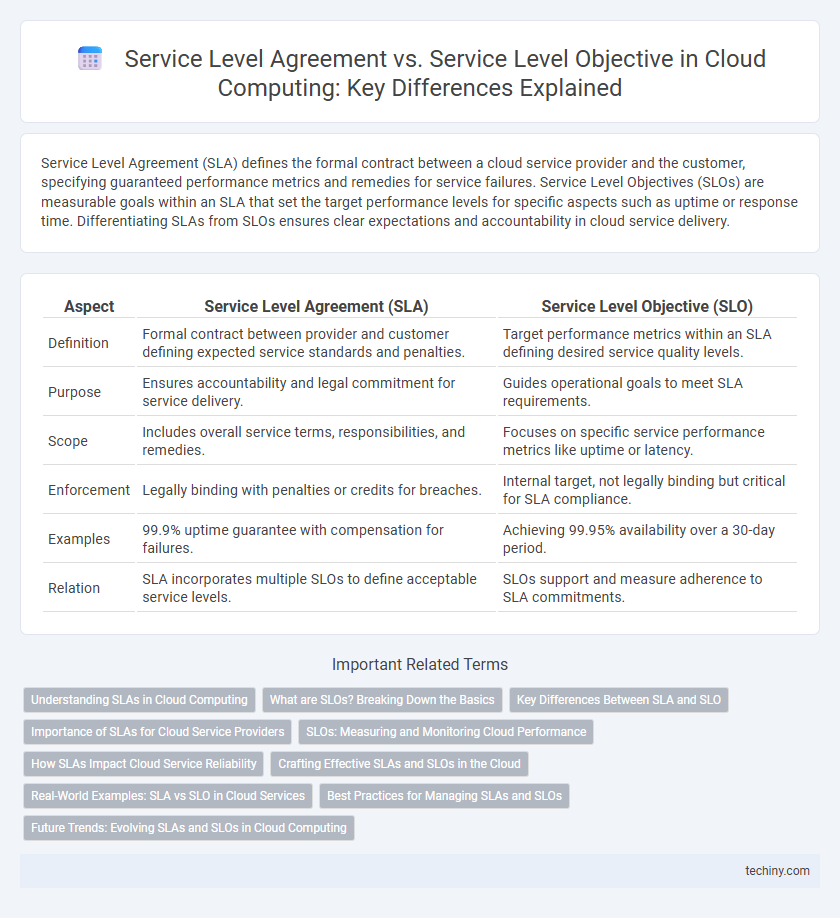Service Level Agreement (SLA) defines the formal contract between a cloud service provider and the customer, specifying guaranteed performance metrics and remedies for service failures. Service Level Objectives (SLOs) are measurable goals within an SLA that set the target performance levels for specific aspects such as uptime or response time. Differentiating SLAs from SLOs ensures clear expectations and accountability in cloud service delivery.
Table of Comparison
| Aspect | Service Level Agreement (SLA) | Service Level Objective (SLO) |
|---|---|---|
| Definition | Formal contract between provider and customer defining expected service standards and penalties. | Target performance metrics within an SLA defining desired service quality levels. |
| Purpose | Ensures accountability and legal commitment for service delivery. | Guides operational goals to meet SLA requirements. |
| Scope | Includes overall service terms, responsibilities, and remedies. | Focuses on specific service performance metrics like uptime or latency. |
| Enforcement | Legally binding with penalties or credits for breaches. | Internal target, not legally binding but critical for SLA compliance. |
| Examples | 99.9% uptime guarantee with compensation for failures. | Achieving 99.95% availability over a 30-day period. |
| Relation | SLA incorporates multiple SLOs to define acceptable service levels. | SLOs support and measure adherence to SLA commitments. |
Understanding SLAs in Cloud Computing
Service Level Agreements (SLAs) in cloud computing define the formal contract between service providers and customers, specifying guaranteed performance metrics such as uptime, response time, and support availability. Service Level Objectives (SLOs) represent specific, measurable targets within an SLA that guide monitoring and compliance efforts to ensure cloud service quality. Understanding the distinction between SLAs and SLOs is crucial for managing expectations, ensuring accountability, and optimizing cloud resource utilization.
What are SLOs? Breaking Down the Basics
Service Level Objectives (SLOs) define specific performance targets within a Service Level Agreement (SLA) that quantify acceptable service quality, such as uptime percentages or response times. SLOs act as measurable benchmarks to ensure cloud service providers meet agreed-upon standards aligned with customer expectations. Clear SLOs enable effective monitoring and accountability, facilitating proactive issue resolution and improved cloud service reliability.
Key Differences Between SLA and SLO
Service Level Agreement (SLA) is a formal contract between a service provider and a customer that defines the expected service performance, responsibilities, and penalties for non-compliance. Service Level Objective (SLO) represents specific measurable targets within the SLA that indicate the desired level of service, such as uptime or response time. The key differences are that SLAs encompass broader legal and operational commitments, while SLOs focus on precise performance metrics used to evaluate whether SLA obligations are met.
Importance of SLAs for Cloud Service Providers
Service Level Agreements (SLAs) define the contractual commitments between cloud service providers and customers, specifying guaranteed performance metrics such as uptime, latency, and support response times. Service Level Objectives (SLOs) are the internal targets that providers aim to meet to fulfill these SLA commitments, serving as benchmarks for operational efficiency and reliability. SLAs are crucial for cloud service providers to establish trust, ensure accountability, and differentiate their services in competitive markets by clearly outlining the expected quality of service and penalties for non-compliance.
SLOs: Measuring and Monitoring Cloud Performance
Service Level Objectives (SLOs) are specific, measurable targets within a Service Level Agreement (SLA) that define the expected performance and availability levels for cloud services. Monitoring SLOs involves continuous tracking of key metrics such as uptime, latency, and error rates to ensure cloud providers meet their committed standards. Effective SLO measurement enables proactive identification of performance issues, ensuring optimal user experience and adherence to contractual obligations.
How SLAs Impact Cloud Service Reliability
Service Level Agreements (SLAs) define the guaranteed uptime and performance metrics that cloud providers commit to deliver, directly impacting cloud service reliability by setting clear expectations for availability and responsiveness. Service Level Objectives (SLOs) serve as measurable targets within SLAs, guiding continuous monitoring and operational adjustments to maintain desired reliability standards. Adhering to SLAs reduces downtime risks and enhances user trust, making SLA compliance critical for maintaining consistent cloud service reliability.
Crafting Effective SLAs and SLOs in the Cloud
Crafting effective SLAs and SLOs in cloud computing involves clearly defining measurable performance indicators such as uptime, latency, and response times to align with business objectives. SLAs represent formal contracts that guarantee specific service standards, while SLOs are internal targets that guide service delivery and continuous improvement. Precise articulation of these agreements ensures customer expectations are managed, compliance is maintained, and cloud service reliability is optimized.
Real-World Examples: SLA vs SLO in Cloud Services
Service Level Agreements (SLAs) in cloud computing define contractual uptime guarantees, such as AWS promising 99.99% availability, ensuring customers receive compensation if service drops below this threshold. Service Level Objectives (SLOs) represent specific performance targets within those SLAs, like Google Cloud setting a 99.9% SLO for API response times to maintain user experience. Major providers use SLOs to monitor service health internally, while SLAs formalize these commitments externally with compensation clauses for breaches.
Best Practices for Managing SLAs and SLOs
Effective management of Service Level Agreements (SLAs) and Service Level Objectives (SLOs) in cloud computing requires clear definition of measurable performance metrics aligned with business goals. Regular monitoring through automated tools ensures adherence to uptime, response time, and reliability targets, enabling prompt identification and resolution of service deviations. Establishing transparent communication channels between providers and clients fosters accountability and supports continuous improvement in service delivery.
Future Trends: Evolving SLAs and SLOs in Cloud Computing
Future trends in cloud computing highlight the evolution of Service Level Agreements (SLAs) and Service Level Objectives (SLOs) towards more dynamic, AI-driven metrics that enable real-time performance adjustments and predictive compliance management. Emerging technologies like machine learning and blockchain enhance the precision, transparency, and automation of SLAs and SLOs, fostering increased trust and accountability between providers and clients. This shift supports more granular, customizable cloud service guarantees tailored to diverse enterprise needs and rapidly changing operational environments.
Service Level Agreement vs Service Level Objective Infographic

 techiny.com
techiny.com